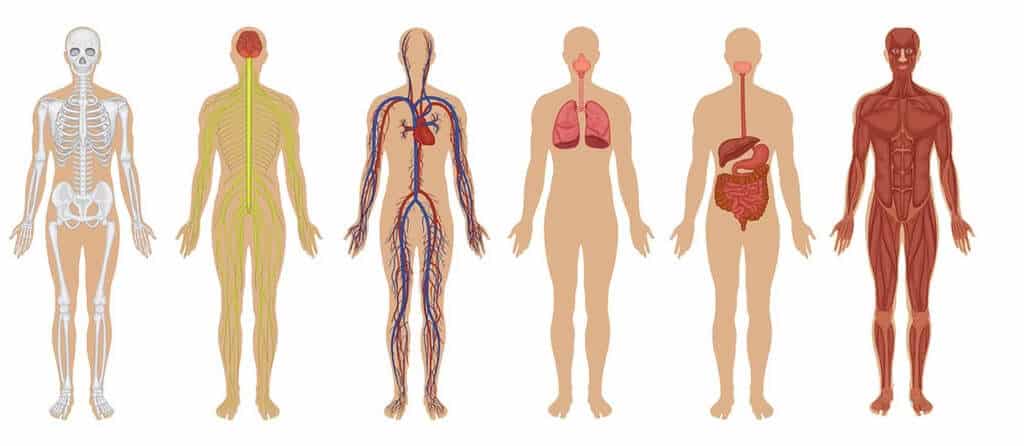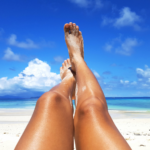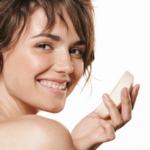Many people think every one of our organs is inside the body—the brain, lungs, heart, kidneys, etc. So this may leave you asking the question, why is the skin considered an organ?
The skin is considered an organ because it fits the definition of all the other organs: An organ is defined as a structure consisting of tissues and cells, all performing a specific function. Skin is a group of “skin cells and tissues” that performs specific “skin functions.”
So just because the skin is on the outside of our body, is so large, and isn’t a small mass packed away inside our body like our other organs, doesn’t mean it is not an organ.
It is made up of its own specific skin cells and has its own specific functions, so it is classified as an organ, just like the heart, liver, brain, and other organs.
In this post, we will discuss not just what the skin is but also its purpose. You will be surprised to know that beyond the surface, it plays a lot of roles in our lives.
Why Is the Skin Considered an Organ?
Between you and the rest of the world lies an interface that makes up 16% of your physical weight. This is your skin. The largest organ in your body: laid out flat, it would cover close to 1.7 square meters of ground.
The Skin Is An Organ, Not Tissue
It is not tissue. As mentioned earlier, human skin is an organ made up of tissue and cells. The skin itself is not tissue. Tissue is defined as any of the distinct types of material of which animals or plants are made, consisting of specialized cells and their products. The skin, the largest organ, is a complex, multi-layered structure that is made up of various cells and tissue such as adipose tissue and sensory tissue.
Skin is Part of the Integumentary System
Skin is also the foundation of the integumentary system. This system incorporates your hair, nails, and specialized glands and nerves. It is made up of three layers: the epidermis, dermis, and hypodermis. Its thickness varies from 0.5 millimeters at its thinnest and up to 4 millimeters at its thickest.
Layers of the Skin
Skin effectively seals off your insides and also absorbs pressure and shock with flexible collagen that makes up most of its dermal layer.
The epidermis is made up mainly of cells called keratinocytes that are completely replaced every four weeks. As new cells form at the base of the epidermis, older ones are pushed up.
The primary function of keratinocytes is the formation of a protective barrier. This protective barrier is what makes the skin an effective defense against heat, water loss, environmental damage, fungi, parasites, UV radiation, pathogenic bacteria, and viruses.
Several structural proteins (filaggrin, keratin), lipids, enzymes (proteases), and antimicrobial peptides (defensins) maintain the essential protective barrier function of the skin. Keratinization is part of a system called cornification in which the keratinocytes make extra keratin.
The fully-formed keratinocytes that form the top layer of the skin are sloughed off on a regular basis and replaced by brand-new cells.
When these cells move upwards, they’re filled with a hardened protein called keratin. Once they reach the surface, they form a tightly overlapping, waterproof layer that’s difficult for invading microbes to breach.
The top layer of the skin is called the stratum corneum. The stratum corneum is our largest organ’s skin barrier. It is the first line of defense protecting us from the environment. It is a strong structure that is a compact collection of lipids and cells with two important purposes.
The first important purpose of the stratum corneum is to protect our insides from harmful UV rays, harmful bacteria, and other harmful assaults. The stratum corneum also ensures that little moisture leaks out, which helps the skin stay fully hydrated.
The Three Functions of Human Skin: Protection, Sensation, and Regulation

The skin, the largest organ, does more than just protect our insides. It carries out three key functions: protecting, regulating, and sensing the world beyond its limits.
Skin’s Function as Protection
On a daily basis, its huge surface processes hundreds, if not thousands, of physical sensations, relying mostly on large, pressure-sensitive skin components called Merkel cells.
In your fingertips alone, there are 750 Merkel cells per each square-centimeter of skin, coupled with over 2,500 receptors that give you your sense of touch.
This surface is also the body’s first major line of defense. Without it, you’d be a soggy mass of tissue and fluids, fatally exposed to the elements.
And the skin is so amazing; when it is cut, it magically grows back. We should be very grateful for our skin as it wants to protect us! Other organs also have the ability to grow and heal if damaged, but the skin is an organ with incredible healing power.
The rate at which the skin heals itself depends on how healthy we are and how well we care for our skin. It wants to keep itself strong and sealed to ensure our insides are fully protected from outside damage.
Immunity
Also, any harmful microbes that make it into the epidermis will encounter Langerhans cells. This group of protective cells detects invaders and communicates their presence to resident immune system T-cells, which react by launching an immune response.
A crucial feature of this immune defense is the several thousand species of microorganisms that inhabit the planes, folds, and crevices of your skin.
These microbes, which include bacteria and fungi, thrive in the sebum, an oily substance that is secreted onto the skin’s surface by sebaceous glands nestled inside the dermis.
These human skin microbes keep the immune system in a state of constant surveillance, ensuring that it’s ready to react if the body really is at risk.
Also, for an excellent product to improve and protect your skin, take a look at our top pick, the Sunday Riley Power Couple Kit:
Click here to see it on Amazon.
Skin’s Function as Regulation
At any given time, up to 25% of the body’s blood is circulating through the dermis, making this process extremely efficient. Under warm conditions, the skin’s sweat glands will secrete sweat via ducts onto the surface, transferring heat out of the body.
These sweat glands are cooling ducts for the body and excrete more than sweat but also other toxins. Hair can also be stimulated to conserve or release body warmth.
The average human has 5 million hair follicles embedded everywhere on the body except the palms of your hands and soles of your feet. 90 to 150,000 of those sweat glands are on your scalp, where they help shield the large surface area of your head from physical damage and sunburn.
When you’re cold, tiny muscles called arrector pili causes hair to stand upright all over the body. That’s the phenomenon known as goosebumps, and it traps body heat close to your skin.
The skin’s vast surface isn’t just a shield; it also enables us to interact and connect with the world. Its multifunctional layer with numerous sweat glands cools us down and keeps us warm. The integumentary system may be many things, but it’s certainly more than skin deep.
Skin’s Function as Sensation
Beyond this protective role, your skin is also a sensory organ that helps regulate your body’s temperature, two roles that are closely interlinked. Nerve endings detect whether your skin is warm or cold and communicate that information to your brain.
In return, the brain instructs localized blood vessels to either expand if the body is too warm. It will then release heat from the blood through the skin. Or to constrict if the body is cold, which retains heat.
Nerve endings are the many millions of tiny points on the upper layer of your body and also inside the body. These nerve endings transmit many messages to the brain when you have sensations, such as pain, heat, and cold.
Each nerve is coated with a thick protective coating of connective tissue. This protective coating is called the epineurium. Underneath this protective coating is a thin layer of cells that form around a bundle of axons. The nerve endings are essential to almost everything we do in life.
Without them, we would not feel pain, so we could seriously hurt ourselves. The skin is not just considered an organ; it is perhaps our most useful and vital organ. Of course, we need all organs to function properly, but the skin is the first line of defense.
Other Organs of the Human Body

Now that you see how the skin is an organ, let’s briefly look at some of the other important organs.
To survive and reproduce, the human body relies on major internal body organs to perform certain vital functions. When two or more organs along with their associated structures work together, they become component parts of a body system.
I have listed below some of the easily recognizable internal organs and their associated functions. Just like the skin, all these are important organs of the body.
Brain
The brain is the control center of the nervous system and is located within the skull. Its functions include muscle control and coordination, sensory reception and integration speech, production, memory storage, and elaboration of thought and emotion.
Lungs
The lungs are two sponge-like, cone-shaped structures that fill most of the chest cavity. Their essential function is to provide oxygen from inhaled air to the bloodstream and to exhale carbon dioxide.
Liver
The liver lies on the right side of the abdominal cavity beneath the diaphragm. Its main function is to process the contents of the blood to ensure that its composition remains the same.
This process involves breaking down fats, producing urea, filtering harmful substances, and maintaining a proper level of glucose in the blood.
Bladder
A muscular organ located in the pelvic cavity. It stretches to store urine and contracts to release urine.
Kidneys
The kidneys are two bean-shaped organs located at the back of the abdominal cavity, one on each side of the spinal column. Their function is to maintain the body’s chemical balance by excreting waste products and excess fluid in the form of urine.
Heart
The heart is a hollow, muscular organ that pumps blood through the blood vessels by repeated, rhythmic contractions.
Stomach
The stomach is a muscular, elastic, pear-shaped bag lying crosswise in the abdominal cavity beneath the diaphragm. Its main purpose is the digestion of food through the production of gastric juices, which break down, mix and churn the food into a thin liquid.
Intestines
The intestines are located between the stomach and the anus. They are divided into two major sections: the small intestine and the large intestine. The function of the small intestine is to absorb most ingested food. The large intestine is responsible for the absorption of water and excretion of solid waste material.
Conclusion
The human skin is considered an organ because it follows the principles of other organs. An organ is defined as a structure consisting of tissues and cells, all performing a specific function.
Skin is a group of cells and tissues that perform specific functions. These functions include protection, sensation, and regulation.
The definition of an organ by Merriam Webster is that it is a collection of related cells that form together to take on specific functions within the body. The skin performs several functions that are very important to the overall health and survival of the body.
As mentioned earlier, the skin is the largest organ in the human body. One of the most important functions of the skin is to protect all other organs in the body.
It also protects nerves, muscles, ligaments, and bones. It is a multi-layered, complex structure that is made up of various tissue and cells such as sensory tissue and adipose tissue.
When the body experiences blood loss from a wound or other sort of cut, the skin heals to constrain the loss of blood. The skin is also an essential regulator of our body temperature by acting as a layer against the cold and dissipating heat through sweat.
Our sense of touch is also very dependent on the skin. Our millions of nerve endings spread throughout skin cells act to exchange information with the outside world, responding to pain, touch, heat, and cold.
So skin may be the black sheep of organs because it is so much bigger than the other organs and is not packed away inside our bodies like the other organs; however, it is still an organ.



![Neutral Skin Tone Defined [and Best Colors for Neutral Skin] neutral skin tone](https://skincaregeeks.com/wp-content/uploads/2021/05/neutral-skin-tone-150x150.png)







